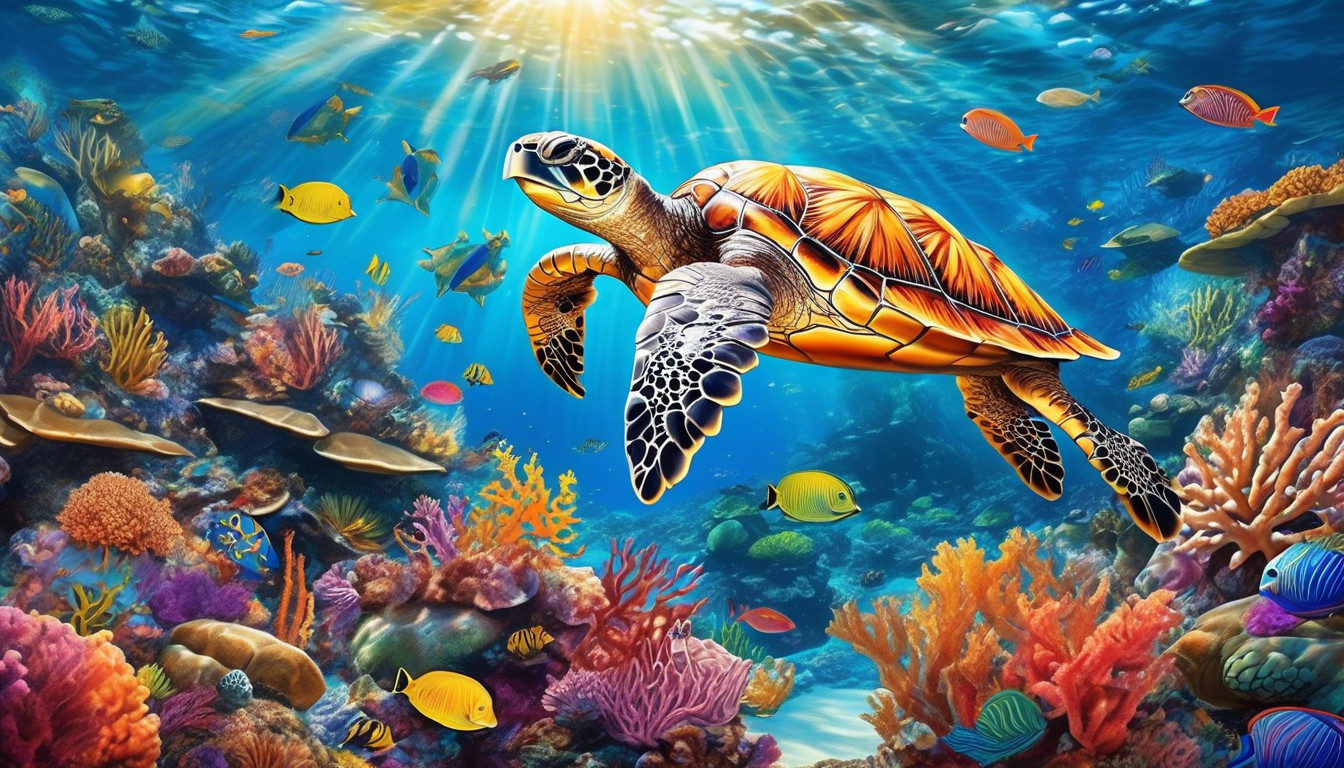
Escrito por Topcontent/AI
10 Fascinating Facts About Sea Turtles
As we embark on this journey to explore the enchanting world of sea turtles, we find ourselves captivated by their grace and longevity. These remarkable creatures, having roamed the oceans for over 100 million years, connect us to a prehistoric past.
In our quest for understanding, we delve into the lives of these ocean wanderers, uncovering fascinating facts that both enlighten and inspire. From their incredible migration patterns to their vital role in maintaining healthy marine ecosystems, sea turtles offer us a glimpse into the delicate balance of life beneath the waves.
Together, we will unravel the mysteries of their survival, resilience, and the challenges they face in an ever-changing world. Join us as we dive into the depths, exploring 10 compelling aspects of sea turtles that will not only intrigue but also deepen our appreciation for these ancient mariners and the oceans they call home.
Ancient Origins
Sea Turtles: Ancient Survivors
Sea turtles have roamed the oceans for over 100 million years, evolving alongside dinosaurs and witnessing the planet's dramatic changes. As evidence of resilience and adaptation, these ancient mariners have survived mass extinctions and continue to navigate vast oceanic distances with precision.
Conservation Lessons and Strategies
In our quest for power, we must harness the lessons of their survival to drive effective conservation efforts. By understanding the migratory patterns of sea turtles, we can implement strategies to protect their crucial habitats and ensure their continued existence.
Our Role in Their Survival
We've got the responsibility and the capability to support their survival, utilizing every tool at our disposal. Sea turtle migration is a testament to their strength, spanning thousands of miles to return to nesting grounds. This journey is not just a marvel of nature; it’s an opportunity for us to focus our resources and knowledge on securing their future.
Call to Action
Let's channel our determination into conserving these ocean giants and preserving the legacy of their ancient origins.
Diverse Species
Among the seven distinct species of sea turtles, each has unique characteristics and plays a vital role in marine ecosystems.
Leatherback Sea Turtles
The leatherback is the largest of them all and is known for its long-distance migration capabilities.
Green Sea Turtles
These turtles are essential for maintaining healthy seagrass beds.
Hawksbill Sea Turtles
Hawksbills, with their striking shells, help control sponges on coral reefs.
Loggerhead Sea Turtles
Loggerheads are famous for their formidable jaws that crush crustaceans.
Each species contributes to the ocean's balance and biodiversity, highlighting their importance as champions of the sea.
Threats and Conservation Needs
Sea turtles face multiple threats that require our attention and action. Our commitment to sea turtle conservation is crucial for preserving their diverse populations.
Key challenges include:
- Habitat destruction
- Pollution
- Illegal poaching
To effectively protect these incredible creatures, we must:
- Understand their migration paths.
- Identify and safeguard nesting sites.
Together, we have the power to ensure sea turtles continue to thrive, supporting the health and resilience of our oceans.
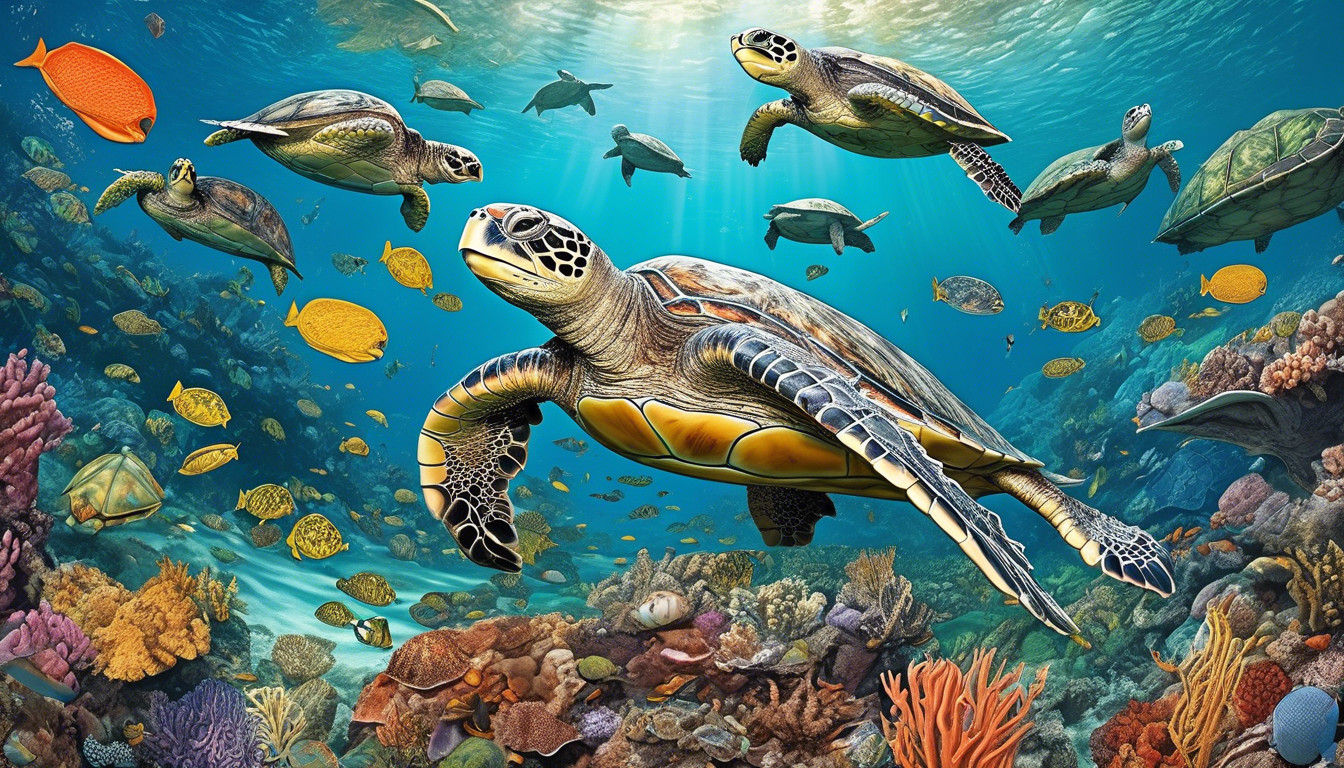
Life Span
Sea Turtle Lifespan and Conservation
Sea turtles can live for several decades, with some species reaching up to 50 years or more. As formidable creatures of the ocean, they embody resilience and longevity, qualities that we can harness in our conservation efforts. Understanding their life span is crucial for protecting these majestic beings.
Conservation Efforts
When we commit to sea turtle conservation, we're not just safeguarding a single generation but ensuring the survival of countless future ones. Their lengthy lives offer us a powerful opportunity to:
- Study migration patterns
- Adapt our strategies to protect their habitats
Migration and Habitat Preservation
Sea turtles embark on extensive migrations, traversing vast oceanic expanses with an innate sense of purpose and direction. This remarkable endurance underscores the importance of preserving their migratory routes.
By doing so, we address the threats they face, such as:
- Habitat destruction
- Climate change
Let’s harness our collective strength to extend their lives even further, ensuring that sea turtles continue to thrive for generations to come.
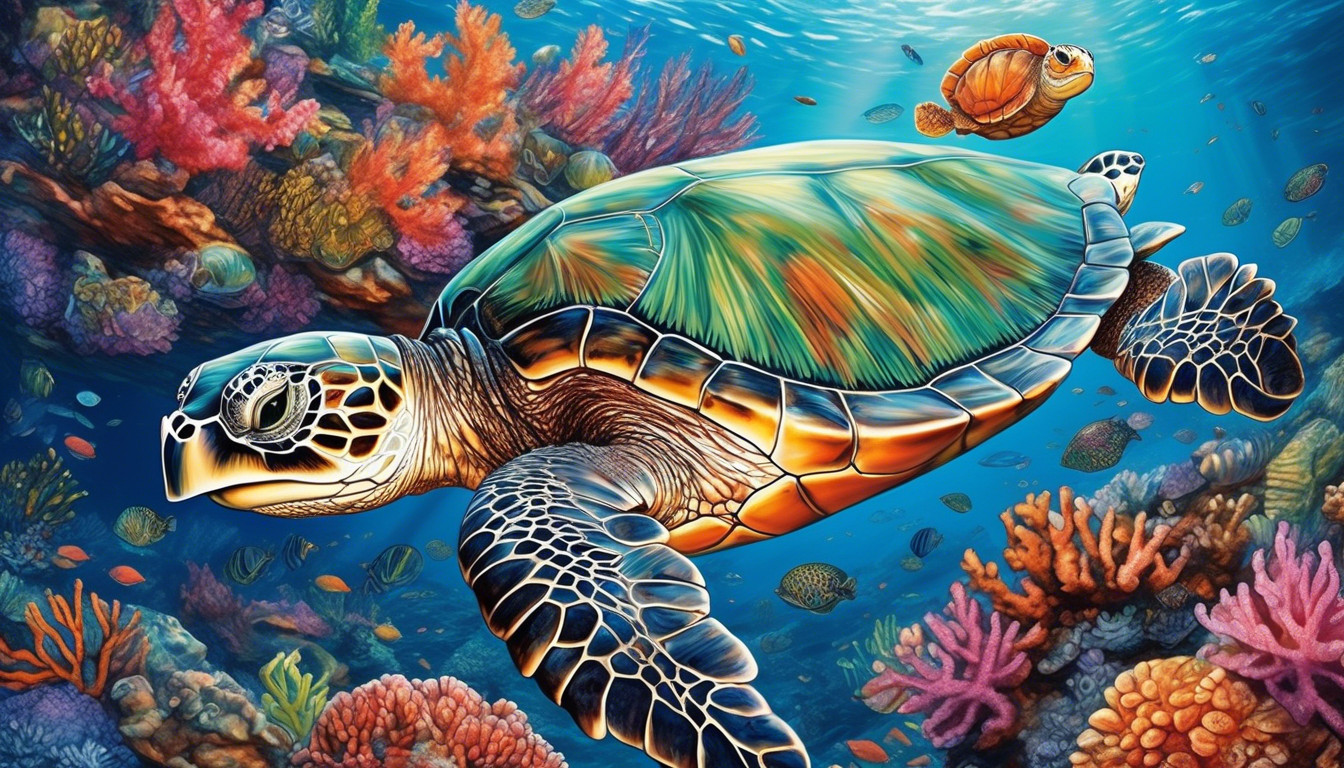
Nesting Behavior
Each year, countless sea turtles return to their natal beaches to lay eggs, showcasing a fascinating nesting behavior that plays a vital role in their life cycle. This instinctive journey, known as migration, demonstrates their remarkable resilience and strength.
As we witness this annual pilgrimage, we're reminded of the power within these creatures and their unwavering connection to their origins. Sea turtles travel thousands of miles, overcoming numerous challenges to reach their birthplace, where new life begins.
Our role in conservation becomes essential as we recognize the importance of these nesting grounds. By protecting these beaches, we ensure the survival of future generations. We must empower ourselves with knowledge and take action to preserve these crucial habitats.
Threats to nesting sites include:
- Coastal development
- Pollution
- Climate change
These threats make conservation efforts more critical than ever.
Together, we can safeguard these majestic sea turtles, securing their legacy and the balance of marine ecosystems. Let's rise to the challenge and champion their cause.
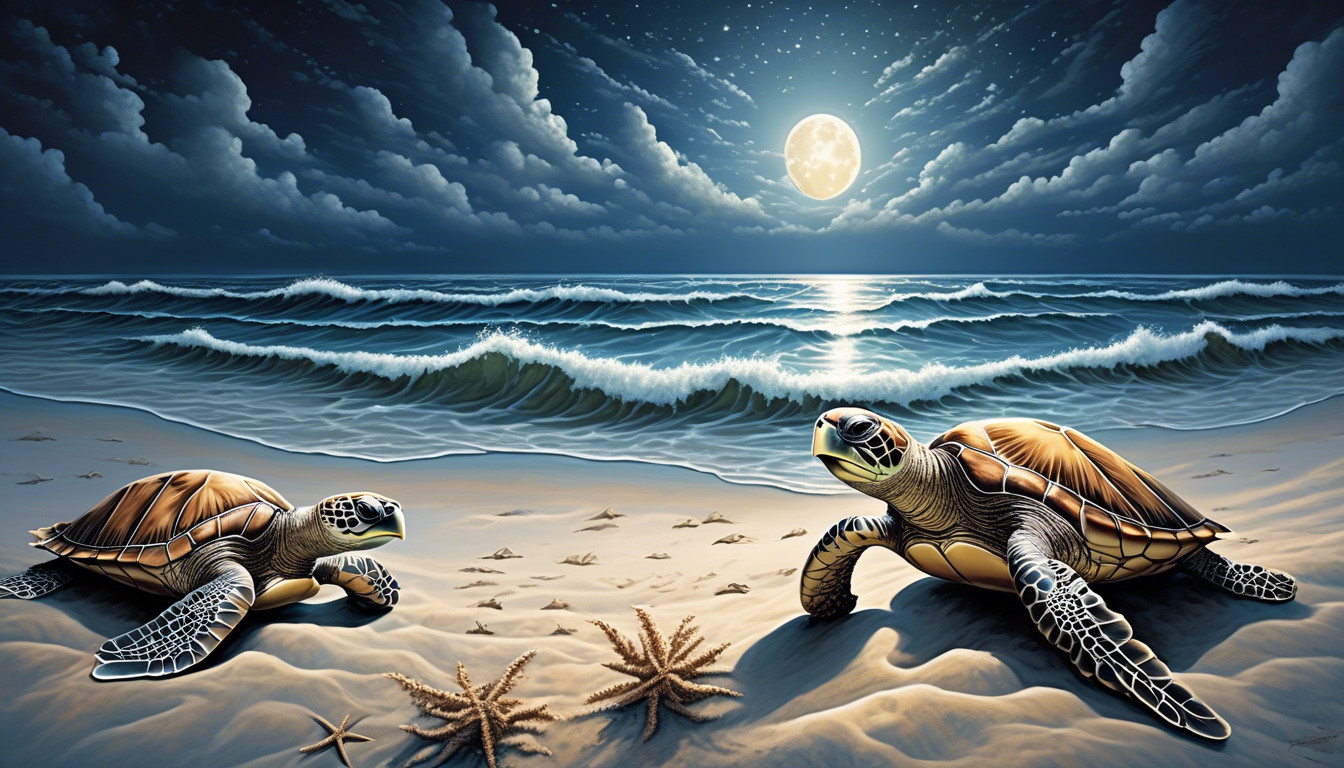
Precise Navigation
Among the most astonishing traits of sea turtles is their ability to navigate with pinpoint accuracy across vast oceanic distances. We, as admirers of these majestic creatures, can't help but marvel at their natural GPS.
Sea turtles embark on epic migrations, traveling thousands of miles between feeding grounds and nesting sites. Their incredible sense of direction is powered by the Earth's magnetic fields, which guide them with the precision of a seasoned navigator.
Understanding this remarkable ability doesn't just fascinate us; it empowers our conservation efforts. By studying their migration patterns, we can better protect their habitats and ensure safe passage across international waters. Sea turtles' navigational prowess exemplifies the resilience and strength we, too, can possess when facing challenges.
Harnessing this knowledge, we can contribute to conservation strategies that preserve these ancient mariners for future generations.
Let’s commit to protecting our oceans and empowering sea turtles, ensuring their survival and enabling them to continue their awe-inspiring journeys.
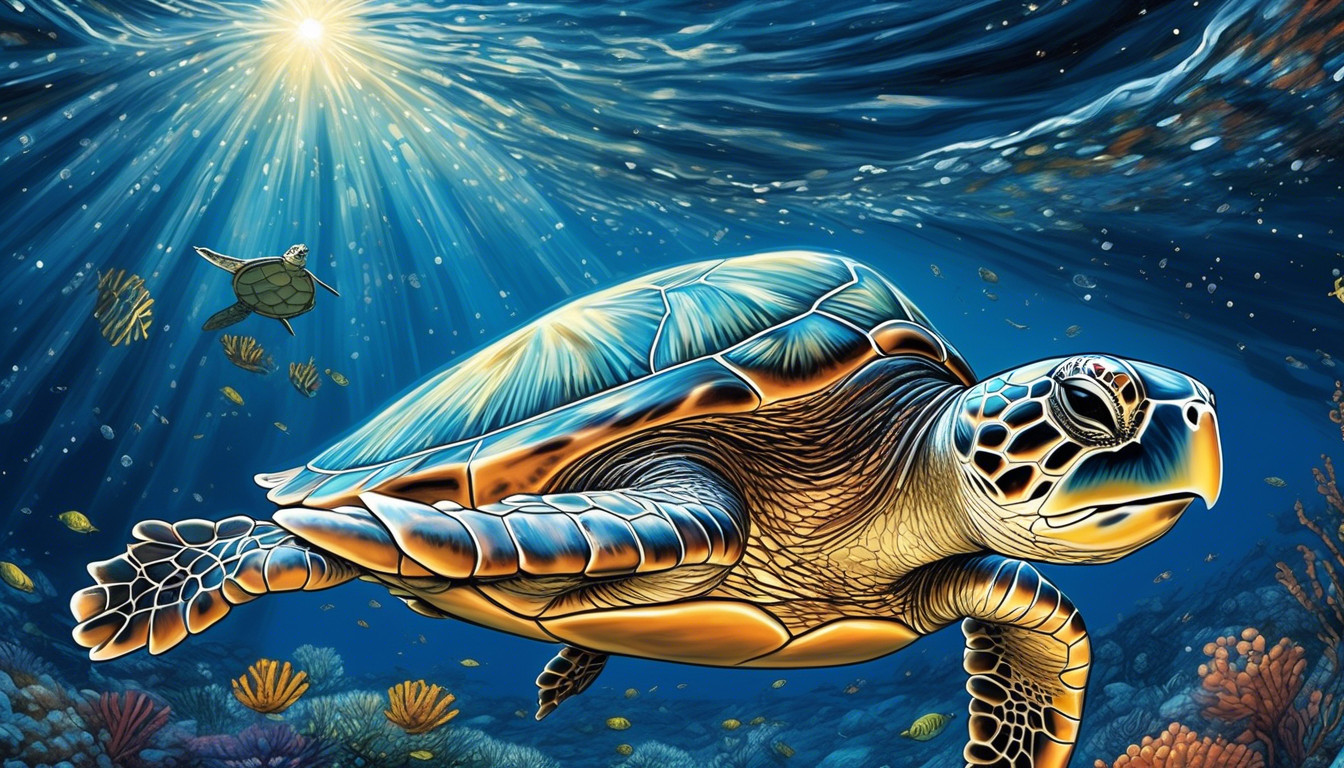
Feeding Habits
Each species of sea turtle has unique feeding habits that play a crucial role in maintaining the ocean's ecological balance. By consuming various organisms, sea turtles help regulate populations and support diverse marine ecosystems.
Sea turtles contribute to the health of marine environments in several ways:
- By consuming jellyfish, they help control jellyfish populations.
- By feeding on sponges, they prevent sponges from outcompeting corals for space.
- By grazing on seagrasses, they promote healthy seagrass beds, which are vital habitats for many marine species.
Their diets promote healthy coral reefs and seagrass beds, providing habitats for countless marine species.
Understanding sea turtles' feeding habits underscores the importance of conservation efforts. As these majestic creatures migrate across vast oceanic distances, they connect ecosystems and maintain the health of the environments they traverse.
Protecting their feeding grounds is essential for preserving not only the turtles but also the intricate web of life they support.
To ensure sea turtles continue their vital role, we must advocate for their conservation. By safeguarding their feeding habitats, we empower the ocean's resilience and secure the future of these extraordinary navigators of the sea.

Threatened Status
Many species of sea turtles face significant threats that have pushed them toward endangered status. Their survival is crucial for maintaining oceanic balance. With their majestic migrations spanning thousands of miles, sea turtles connect ecosystems and play a vital role in marine life health.
Unfortunately, these remarkable creatures confront challenges such as:
- Habitat loss
- Pollution
- Illegal poaching
These challenges cripple their ability to thrive.
We have the power to reverse this dire situation. By understanding the gravity of these threats, we align ourselves with the forces of change. The decline in sea turtle populations is a call to action, reminding us that conservation is not just an option but a responsibility.
Sea turtles are sentinels of the sea, and their survival reflects our commitment to preserving the natural world. Together, we can ensure that future generations witness the awe-inspiring migrations of these ancient mariners.
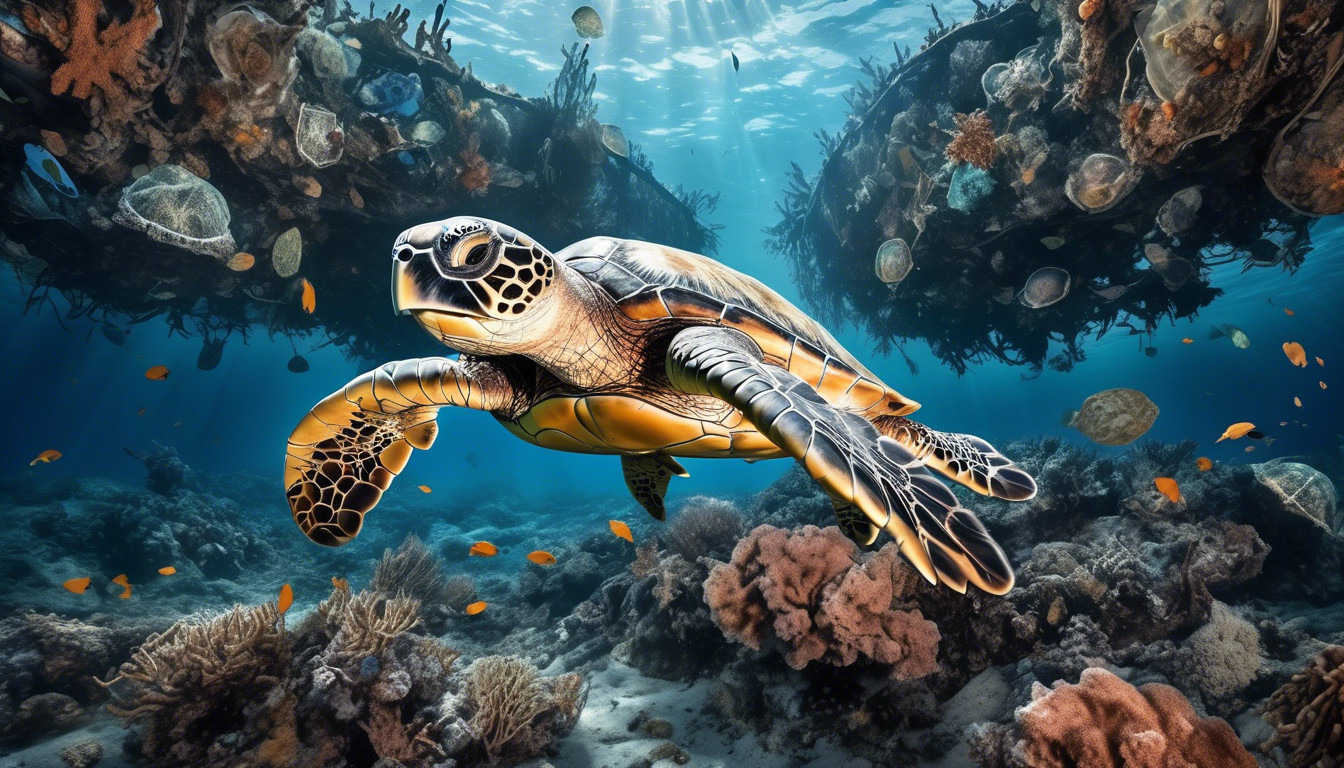
Conservation Efforts
Numerous initiatives worldwide aim to protect sea turtles by addressing threats like habitat loss, pollution, and poaching. We've taken bold steps to ensure these magnificent creatures continue their ancient migrations across our oceans. By supporting conservation programs, we're not just preserving sea turtles; we’re safeguarding the balance of marine ecosystems, which grants us power over the health of our planet.
Collaborative projects between governments, NGOs, and local communities have become crucial. Together, we’ve:
- Established protected areas
- Enforced stricter regulations on fishing practices to prevent bycatch
- Promoted the use of turtle-friendly lights to reduce disorientation caused by artificial lighting
Through education and awareness campaigns, we empower individuals to make informed choices that support sea turtle conservation. By:
- Reducing plastic consumption
- Participating in beach clean-ups
We contribute directly to their survival. Each action we take strengthens the resilience of sea turtles, ensuring their majestic migrations continue for generations to come. Our efforts make a difference.
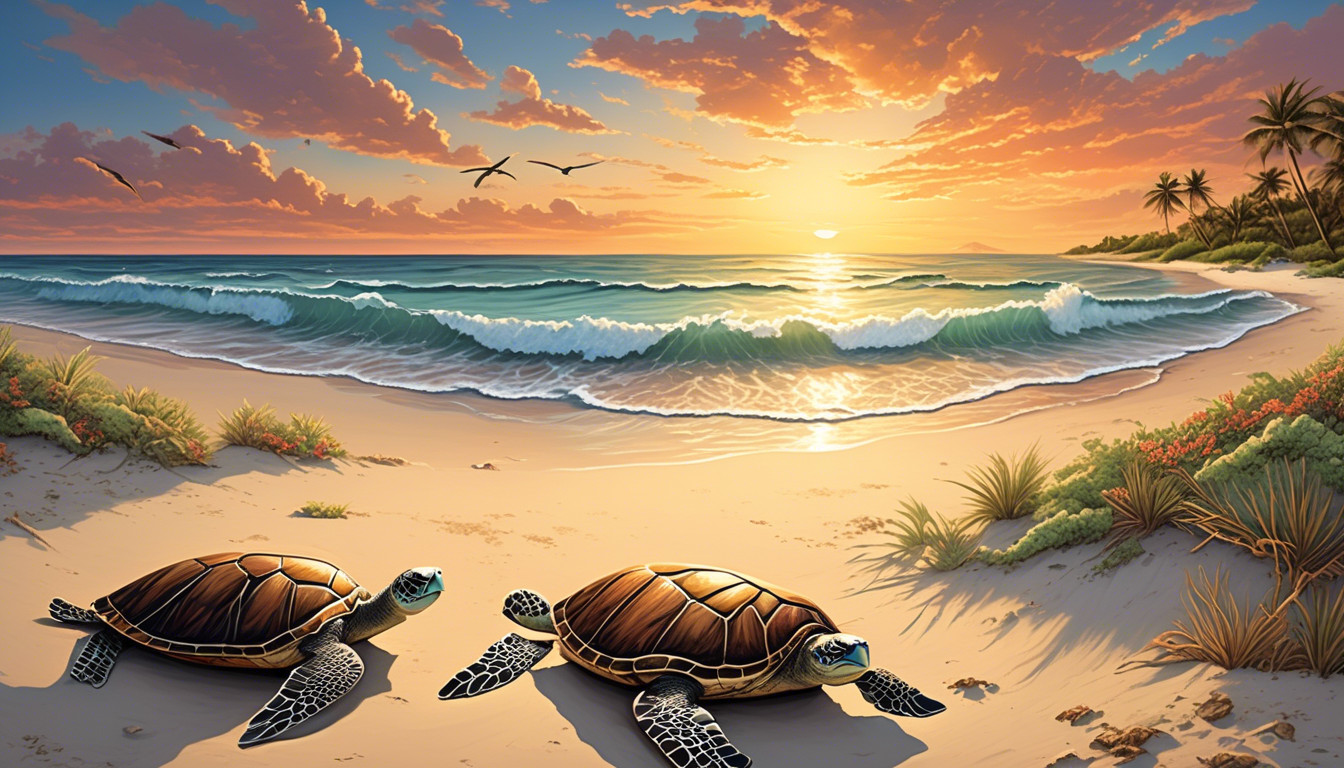
Nesting Sites
Nesting sites are vital for sea turtles, as they need safe beaches to lay their eggs and ensure the next generation thrives. By protecting these nesting beaches, we directly influence the survival of sea turtles, securing their continued existence.
Our role in conservation empowers us to shape a future where these magnificent creatures continue their incredible migrations across the oceans.
These sites aren’t just random stretches of sand; they are carefully chosen by sea turtles through instinct honed over millennia. Female turtles return to the same beaches where they were born, demonstrating nature’s unwavering loyalty.
Our responsibility is to maintain these sites, ensuring they remain undisturbed by human interference. This is our chance to wield our influence for good.
By safeguarding nesting sites, we take control of a vital part of the sea turtle’s life cycle, reinforcing our commitment to the conservation of these majestic marine animals.
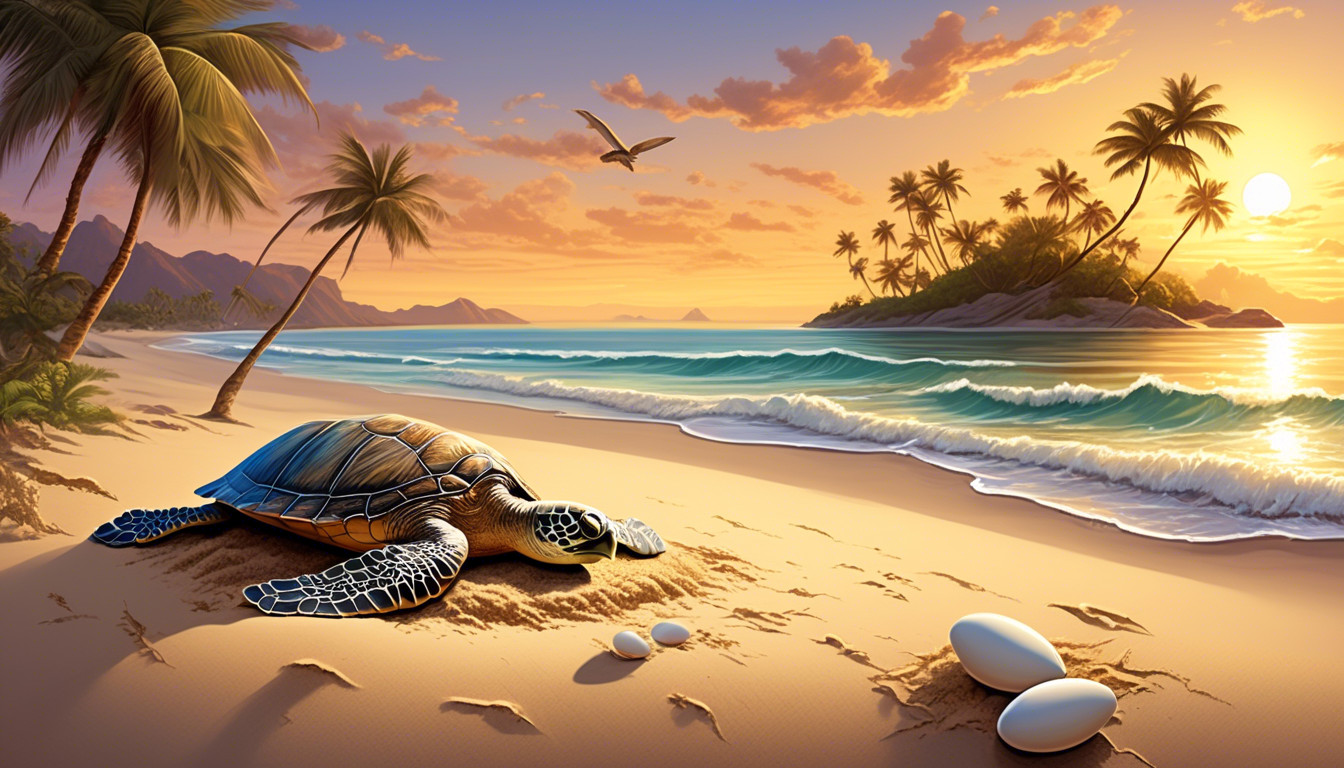
Hatchling Journey
With the moonlight guiding them, hatchlings embark on their perilous journey from nest to sea, facing numerous threats along the way. This trek is more than a passage; it's a rite of survival that sets the stage for their future migration across vast oceans. As we witness these tiny sea turtles push forward, we recognize the raw determination and instinct driving them. Their journey is not just theirs alone—it’s a testament to the resilience of nature.
Our role in conservation has never been more critical. By safeguarding their nesting sites and ensuring safe passage to the ocean, we empower these hatchlings to continue their life cycle. Each successful journey strengthens their population, contributing to the intricate balance of marine ecosystems.
Together, we can harness our collective power to protect and preserve these magnificent creatures.
As hatchlings reach the sea, they embark on their first migration, a voyage that spans continents and challenges the limits of survival.
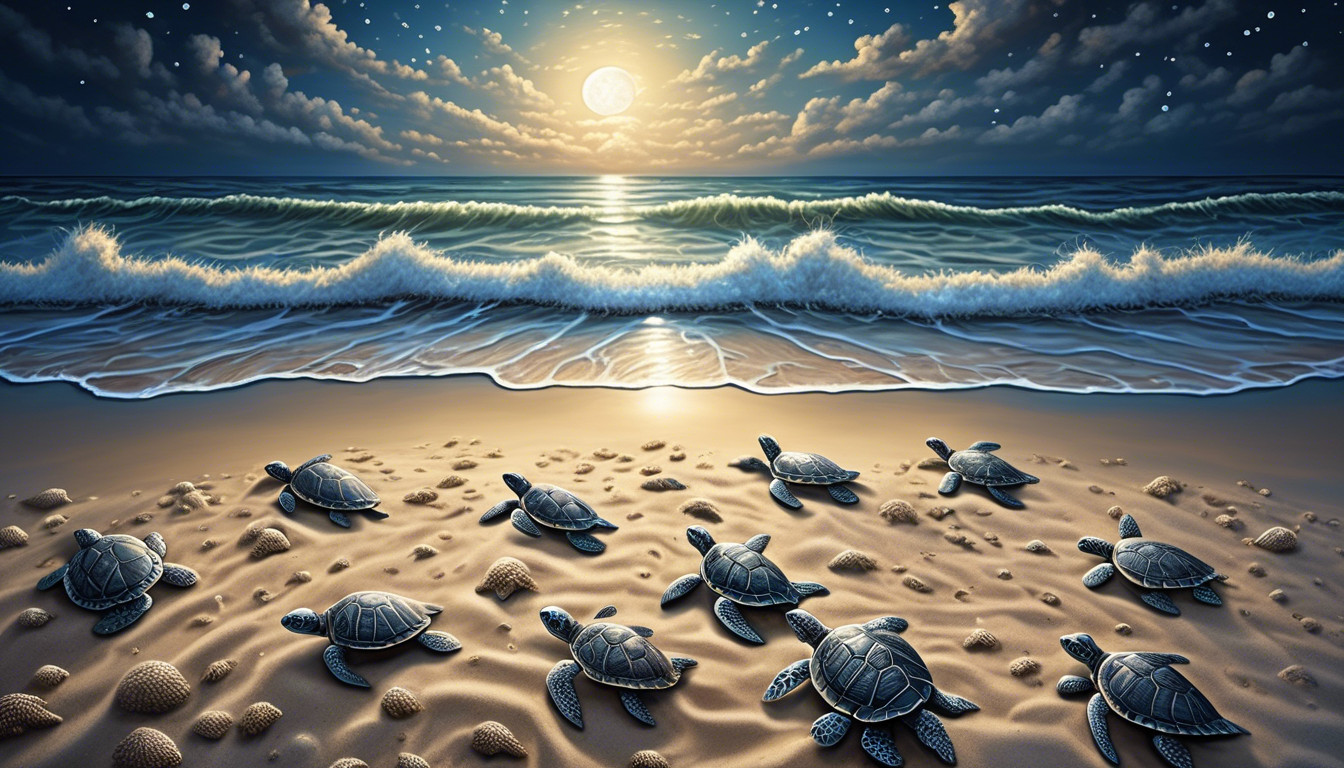
Predators and Threats
Numerous natural predators and human-induced threats jeopardize the survival of sea turtles at every stage of their life cycle.
From the moment they hatch, sea turtles face the daunting challenge of evading predators such as:
- Birds
- Crabs
- Fish
As they migrate through vast oceans, they encounter formidable foes like sharks and orcas, which test their resilience.
Human-Induced Threats:
We know that human activities dramatically impact sea turtles. These include:
- Bycatch in commercial fishing operations, which indiscriminately claims lives
- Plastic pollution, which chokes and entangles sea turtles
- Coastal development, which disrupts nesting sites, leaving little room for these ancient mariners to thrive
Conservation Efforts:
Our conservation efforts must be robust and relentless. We have the power to:
- Implement changes that safeguard their migration routes
- Protect their habitats
Together, we can ensure that these magnificent creatures not only survive but flourish for generations to come. Let’s harness our collective strength and make a difference.
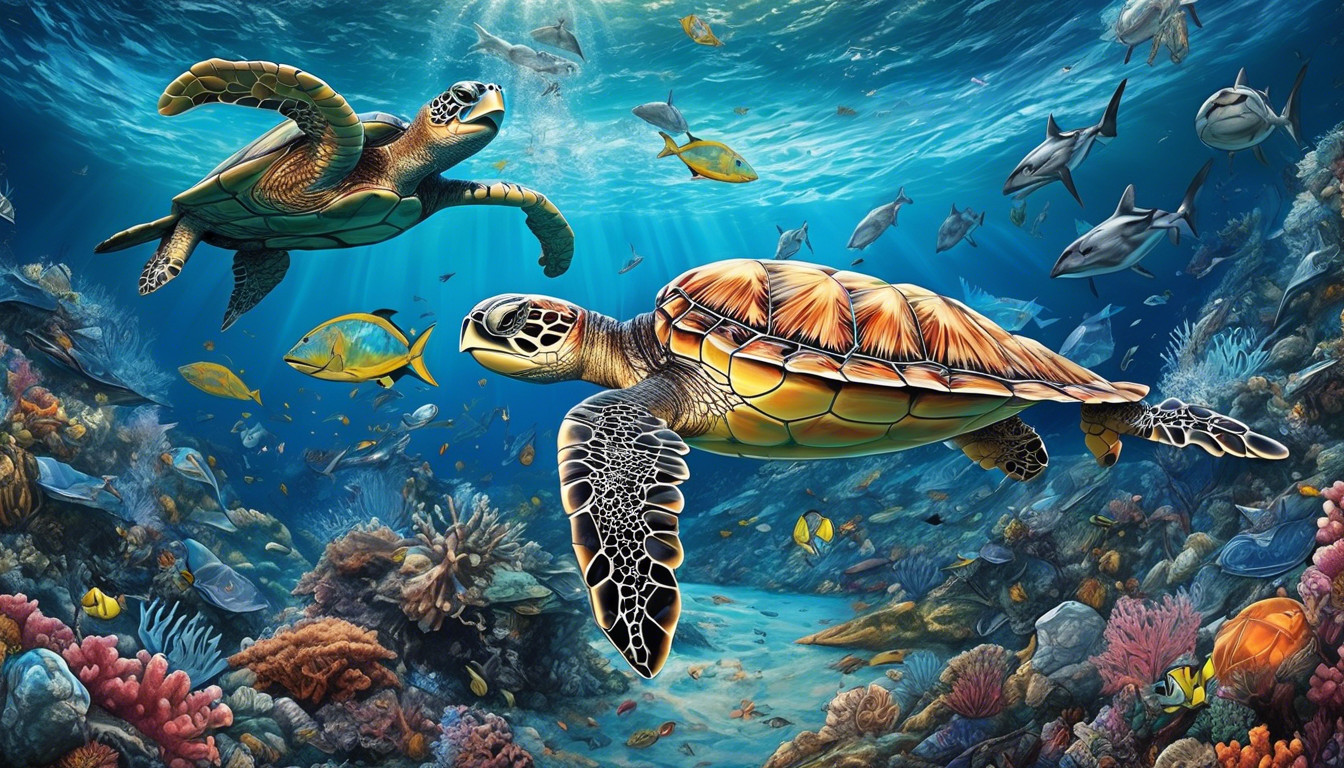
Temperature-Dependent Sex Determination
A fascinating aspect of sea turtle biology is that the temperature of the sand where their eggs are incubated determines the sex of the hatchlings. Warmer sands generally produce female hatchlings, while cooler sands yield males. This temperature-dependent sex determination is crucial, as it directly influences the gender balance within sea turtle populations.
Human activities, like climate change, are altering sand temperatures, threatening this balance. To ensure the survival of sea turtles, we must focus on effective conservation strategies.
Conservation Strategies:
- Control nesting environments.
- Safeguard migration routes.
- Implement protective measures at nesting sites.
By committing to these actions, we not only protect sea turtles but also reinforce our role as stewards of the planet. Through targeted, strategic efforts, we drive positive change and help stabilize sea turtle populations, maintaining the natural equilibrium of these magnificent creatures.
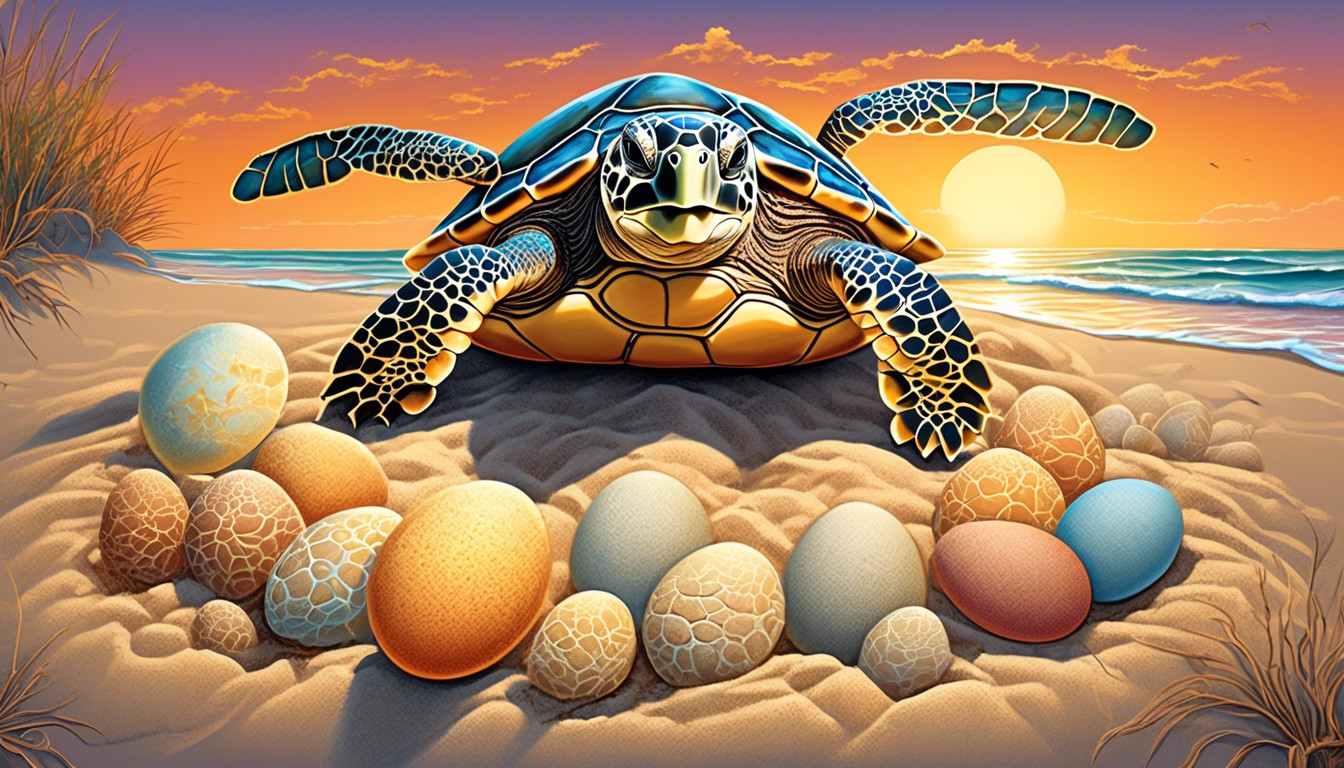
Size Discrepancies
Among sea turtles, size discrepancies are notable, with some species like the leatherback growing over 1,000 pounds, while others, such as the Kemp's ridley, remain much smaller. These differences in size aren't just fascinating; they also impact our conservation strategies.
Larger turtles, like the leatherback, have the following characteristics:
- Extensive migration patterns, often crossing entire oceans.
- Immense size and strength that allow them to travel vast distances.
This highlights the need for international cooperation in conservation efforts.
Smaller species, such as the Kemp's ridley, tend to have:
- More localized migration routes.
This means our conservation efforts can be more regionally focused but need to be just as powerful.
We must tailor our strategies to protect these unique creatures, acknowledging their distinct needs based on size and migration patterns.
Understanding these discrepancies empowers us to create effective measures, ensuring that every sea turtle species thrives, regardless of their size.
Let's harness this knowledge and act decisively.
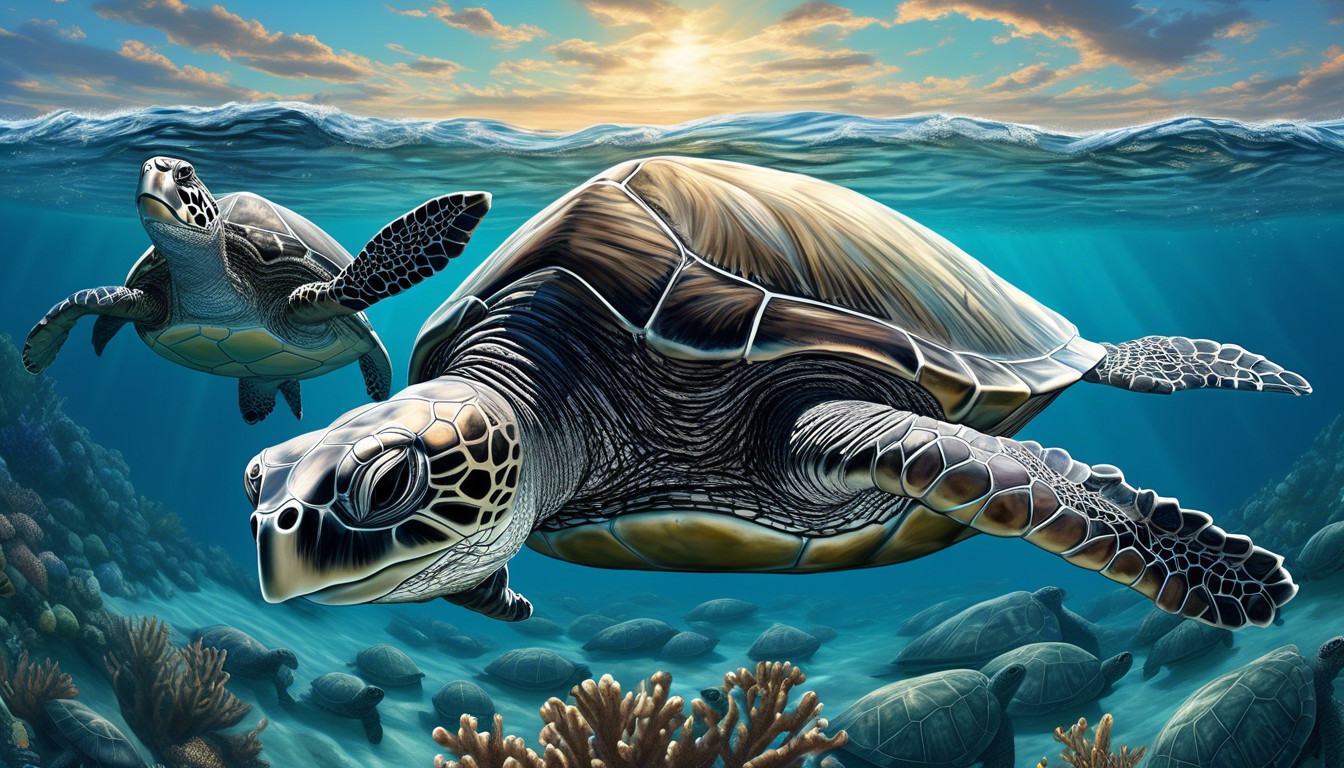
Role in Ecosystems
Sea Turtles and Marine Ecosystems
These remarkable creatures play a vital role in maintaining the health and balance of marine ecosystems.
Contributions to Coral Reefs and Seagrass Beds
- Sea turtles traverse vast ocean expanses, directly contributing to the vitality of coral reefs and seagrass beds.
- As they graze on seagrass, they help increase its productivity and nutrient content, supporting a diverse range of marine life.
- By controlling jellyfish populations, they prevent ecological imbalances that could disrupt the food chain.
Conservation Efforts
Our efforts in sea turtle conservation empower us to protect these essential marine architects. By ensuring their survival, we safeguard the intricate networks of life they support.
- As sea turtles migrate across oceans, they connect ecosystems.
- They transport nutrients that enrich both the waters and the creatures within.
The Broader Impact
When we champion sea turtle conservation, we're not just preserving a species; we're asserting our role as stewards of the planet's marine wealth. Together, we can harness our collective power to maintain the delicate balance of our oceans.
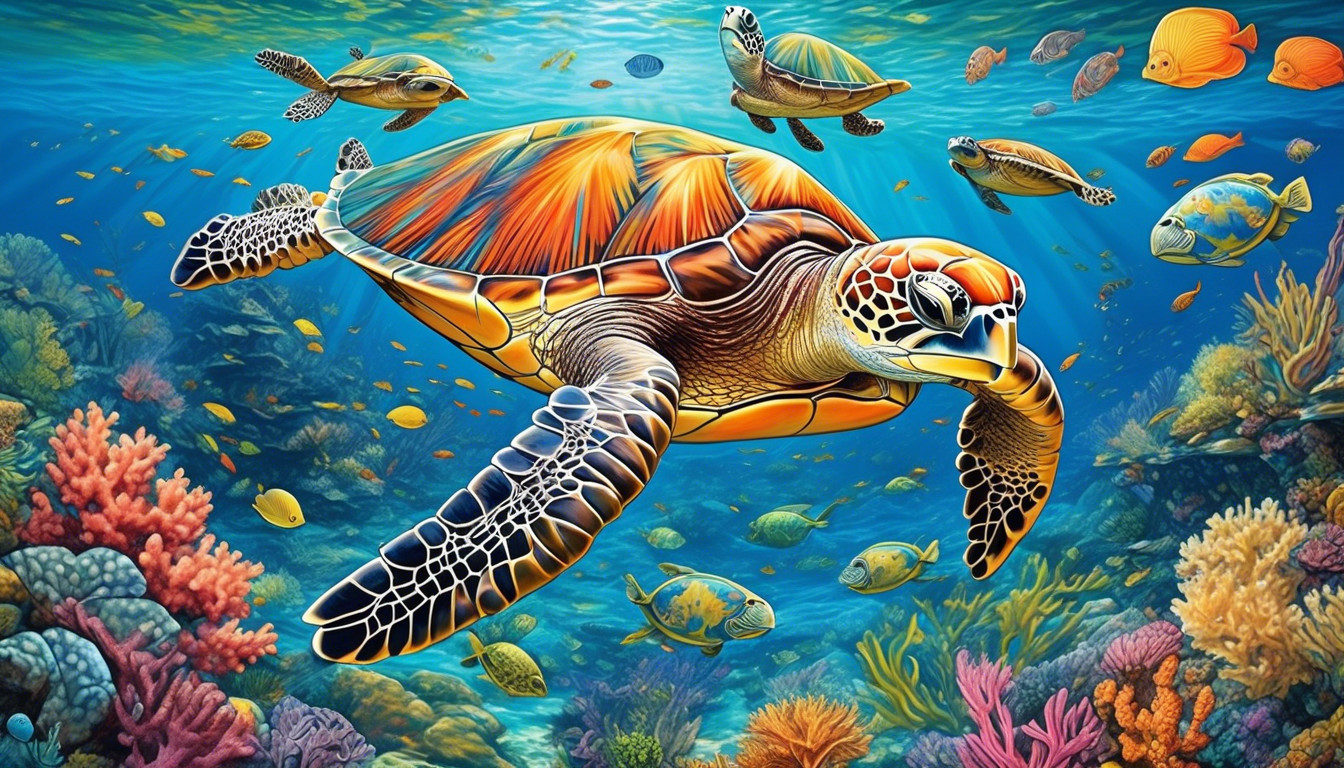
Migratory Routes
Every year, countless sea turtles embark on long and arduous journeys across the oceans, navigating ancient migratory routes with remarkable precision. We marvel at their innate ability to traverse thousands of miles, guided by the Earth’s magnetic fields and instincts honed over millions of years. These extraordinary migrations are a testament to their resilience and serve as a powerful reminder of the interconnectedness of our planet’s ecosystems.
As we witness these incredible feats, we recognize the urgent need for conservation. Protecting these migratory routes is crucial to ensuring the survival of sea turtles. By safeguarding their paths, we help preserve the delicate balance of marine life. Our actions can empower these majestic creatures to continue their age-old journeys, undeterred by human intrusion.
Migration is more than a journey; it's a vital link in the circle of life. Together, we hold the power to protect and conserve these routes, ensuring sea turtles thrive for generations to come.
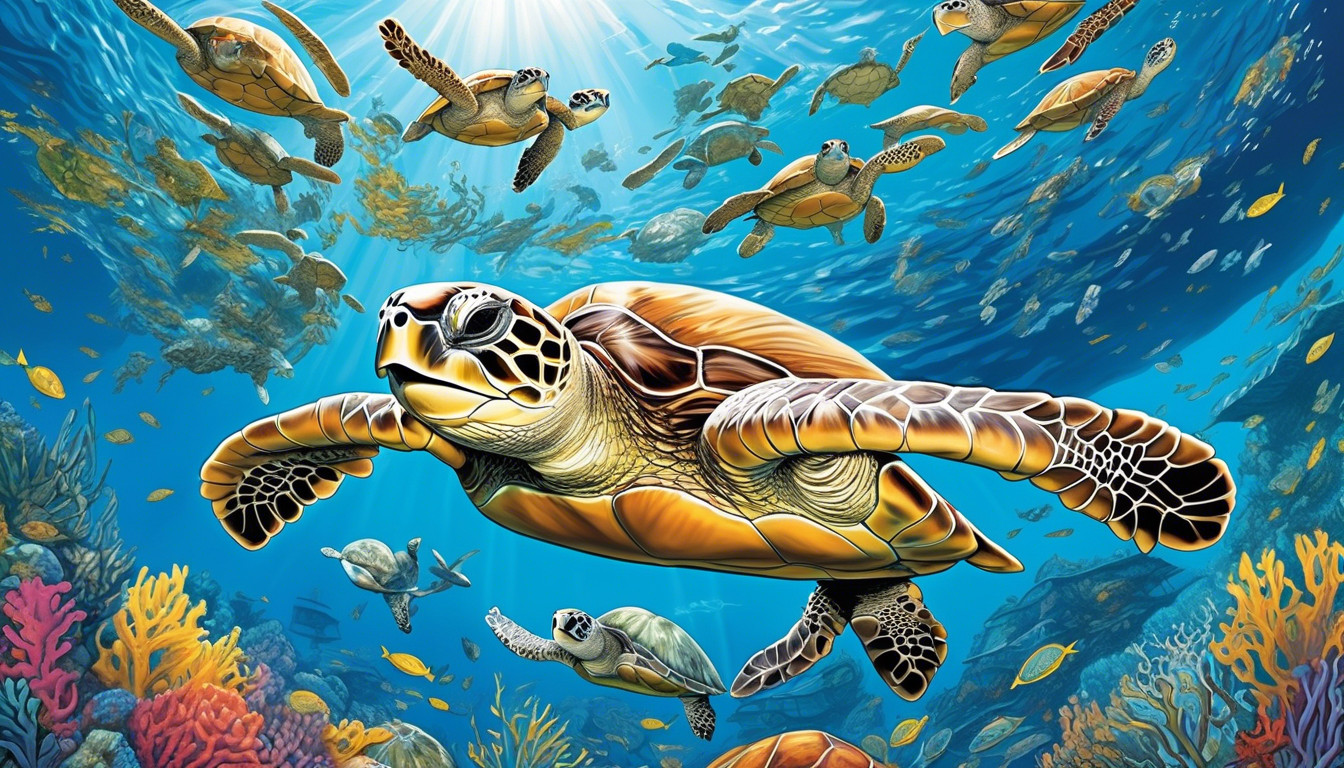
Marine Debris Impact
Amidst the vastness of the ocean, countless pieces of marine debris pose a significant threat to the well-being and survival of sea turtles. As we strive for conservation, we must recognize how our actions directly impact these majestic creatures.
Sea turtles, during their long migrations, often mistake plastic bags for jellyfish or become entangled in discarded fishing gear. This not only disrupts their migratory routes but also endangers their lives.
We have the power to change this narrative. By reducing single-use plastics and supporting clean ocean initiatives, we can significantly decrease the marine debris that jeopardizes sea turtle populations.
Our commitment to conservation efforts is crucial in ensuring these ancient mariners continue their journey across the seas.
Together, we can harness our collective strength to create a safer environment for sea turtles. Let’s take decisive action, not just for their survival, but to uphold the balance of our oceans and preserve them for future generations.
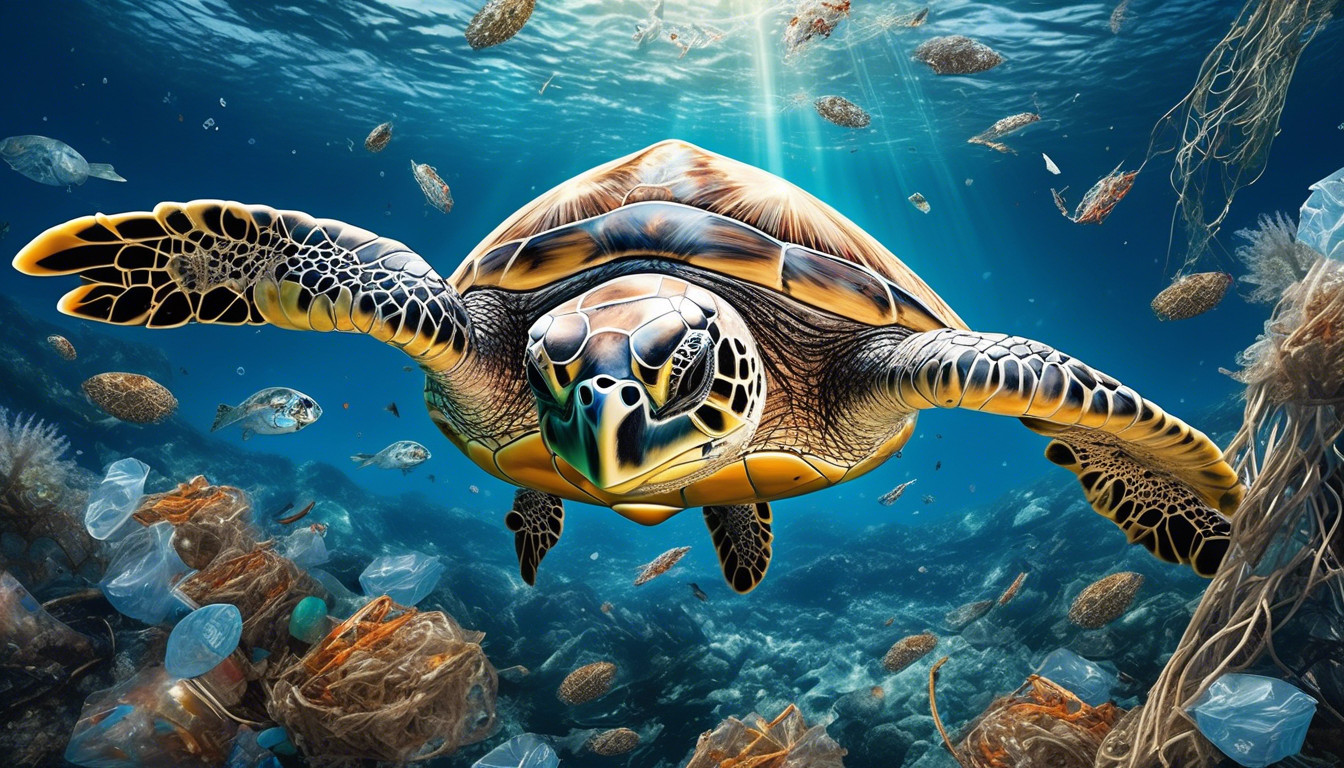
Global Distribution
Sea Turtles' Global Distribution and Adaptability
Sea turtles inhabit nearly every ocean basin around the world, showcasing their incredible adaptability and resilience. These majestic creatures traverse vast distances, reminding us of the interconnectedness of our planet. From the warm beaches of the Caribbean to the icy waters near Alaska, sea turtles are a testament to nature's perseverance. Their global distribution underscores the importance of conservation efforts to protect these ancient mariners.
Migration Patterns and Challenges
Our responsibility extends beyond our local shores, as sea turtle migration patterns reveal the vast expanse of their journey. They navigate thousands of miles, following ancient paths to feed and nest. As they cross international waters, sea turtles face several threats, including:
- Habitat destruction
- Poaching
- Climate change
These challenges demand global cooperation and powerful conservation strategies.
Conservation Efforts and Knowledge Sharing
By understanding the global distribution of sea turtles, we gain insight into the strength and determination of these creatures. Together, we can harness this knowledge to support effective conservation initiatives, ensuring that sea turtles continue to thrive for generations to come.
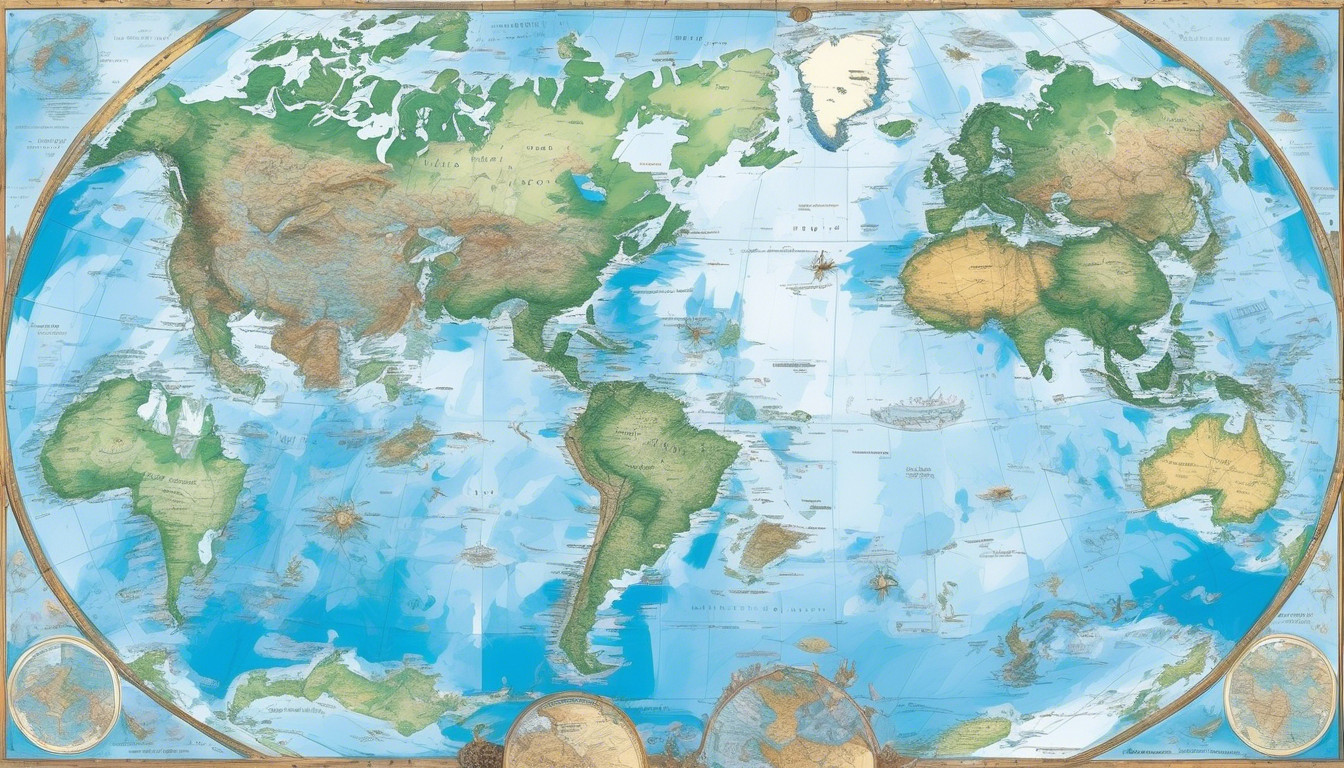
Unique Adaptations
One remarkable adaptation sea turtles have is their streamlined shells, which enable them to glide effortlessly through ocean currents. It’s this design that gives them the power to undertake long migrations across vast oceans.
Sea turtles possess an incredible sense of navigation, allowing them to travel thousands of miles to return to the very beaches where they were born. This instinctual migration is a testament to their resilience and adaptability.
- Their powerful flippers not only propel them through the water but also allow them to dig nests in the sand for their eggs.
Conservation Efforts:
- Acknowledge the need for diligent conservation efforts to ensure these magnificent creatures continue to thrive.
- Harness the knowledge of their navigation and adaptability to strengthen our resolve in protecting their habitats.
- Work together to ensure that sea turtles continue to rule the oceans with their unmatched grace and strength.
These unique adaptations highlight the necessity of a concerted conservation effort.
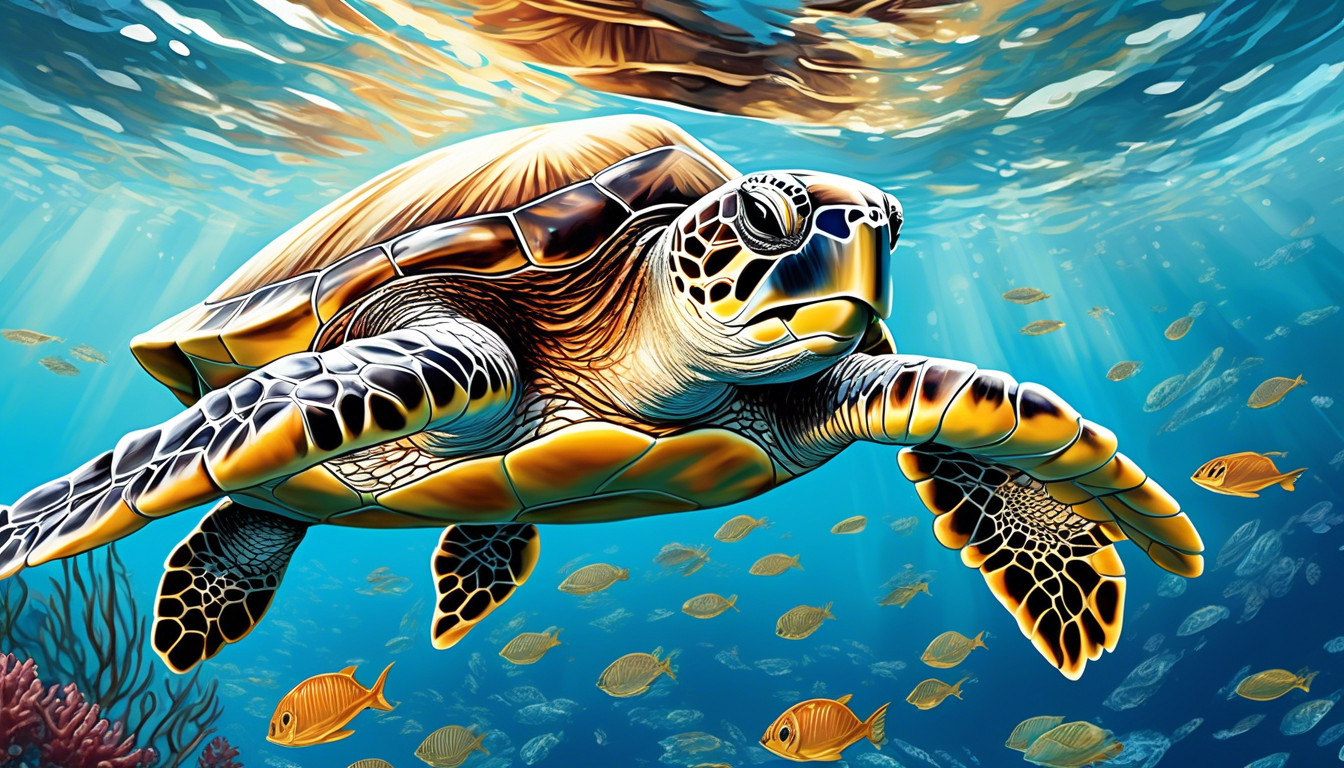
Population Decline
Despite our efforts, many sea turtle populations are dwindling due to habitat loss, pollution, and illegal poaching. As stewards of the planet, we wield the power to change this trajectory. Sea turtles are vital to marine ecosystems, and their decline is a stark warning. We must harness our influence to foster effective conservation strategies.
Pollution:
- Chokes their nesting beaches
- Clogs migration routes, making survival a constant battle
Illegal poaching:
- Strips them of their future, as eggs are stolen for short-term gain
Our actions can reverse this trend through:
- Policies that protect their habitats
- Punishing offenders
In our quest for dominance over nature, we can't ignore the ripple effects our actions have on sea turtles. By:
- Supporting conservation initiatives
- Advocating for cleaner oceans
We ensure their migration patterns remain intact. Together, we have the power to halt the decline and secure a thriving future for these majestic creatures.
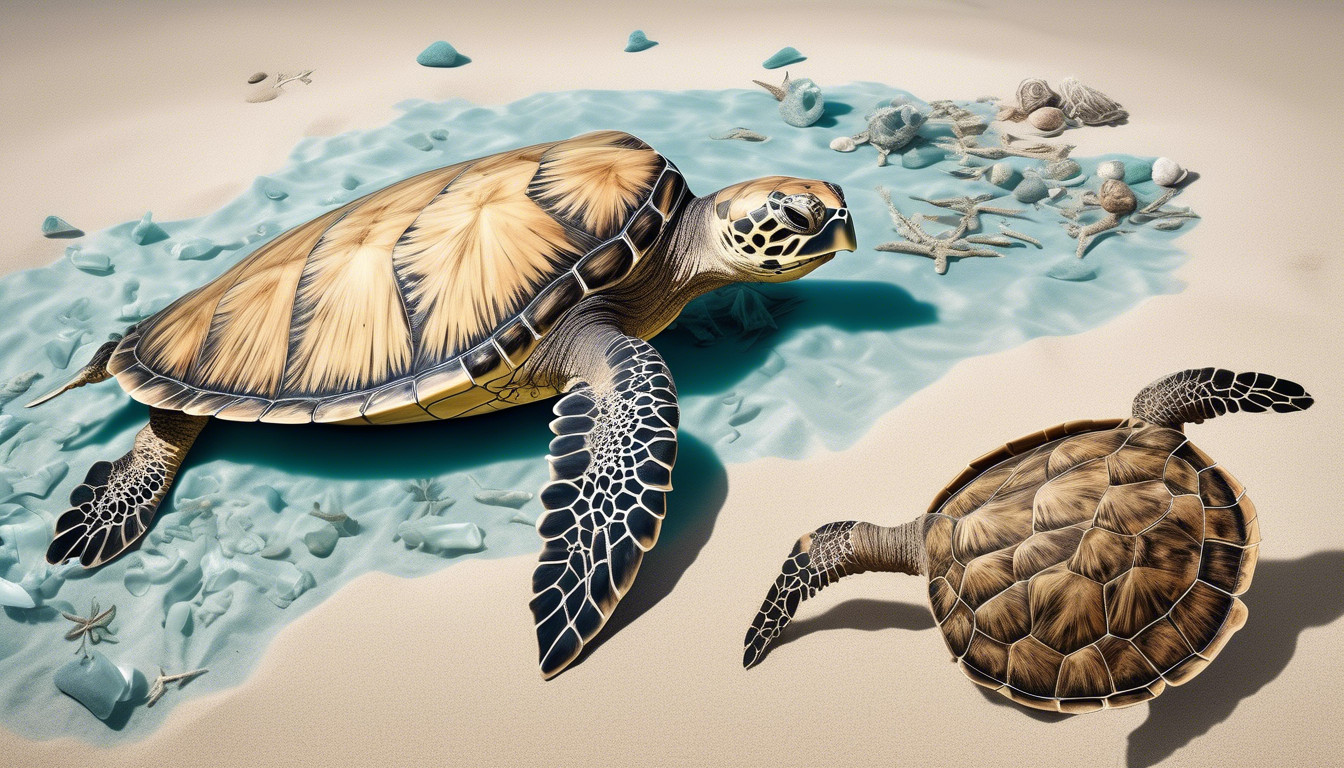
Rescue and Rehabilitation
Every year, dedicated teams rescue countless sea turtles that are injured or stranded, giving them a chance to recover and return to the wild.
Our efforts in conservation empower us to make a tangible impact on these ancient mariners. We harness our resources and expertise to address the threats sea turtles face during their epic migrations. By rehabilitating them, we bolster their populations and ensure they continue their vital roles in marine ecosystems.
With precision and determination, we intervene when sea turtles are compromised by human interference or natural challenges.
- From disentangling them from fishing gear to treating injuries, our work is both a science and an art.
We’re not just saving individual turtles; we’re safeguarding entire species and the balance of oceanic life.
Through collaboration and innovation, we turn obstacles into opportunities. Our success stories inspire others to join the fight, creating a powerful network committed to the preservation of sea turtles and their migratory paths.
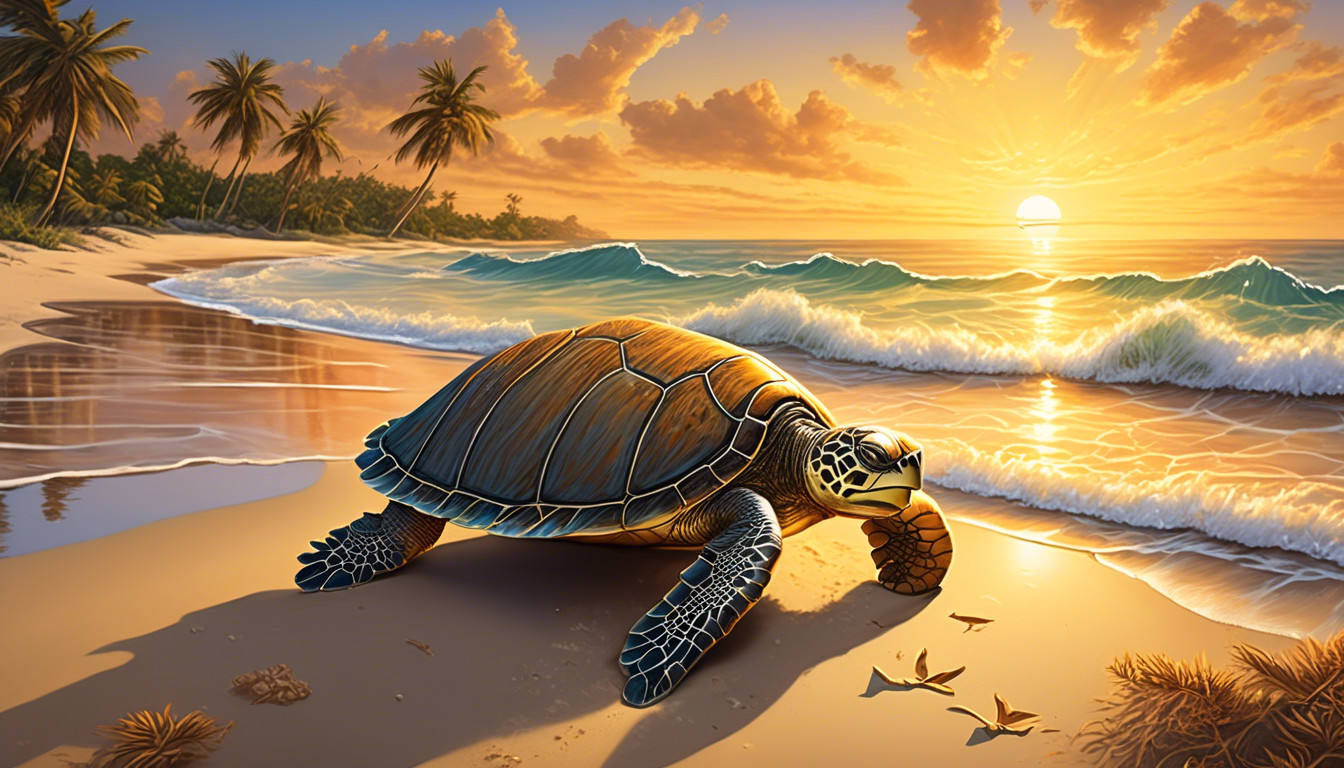
Future Challenges
Despite our successes, we're facing numerous challenges that threaten the future of sea turtles and their habitats. Climate change is a major factor, as it is altering ocean temperatures, which affects sea turtle migration patterns and nesting sites. Rising sea levels and increased storm intensity further exacerbate the situation by eroding beaches, leaving less room for sea turtles to lay eggs. If we want to maintain control over these precious ecosystems, we must act decisively.
Pollution also poses a significant threat. Plastics and debris in the ocean can be lethal to sea turtles, who often mistake them for food. To reduce these hazards, we must:
- Implement stricter waste management policies
- Promote global collaboration
Illegal poaching and egg harvesting continue to undermine conservation efforts, challenging our ability to protect these creatures. To combat these threats effectively, we should:
- Enforce stricter laws
- Invest in community education
The battle for sea turtle conservation is ours to win. Together, we can ensure their migration remains a timeless journey for generations to come.
Escrito por Topcontent/AI
Artículo creado por Topcontent/AI
Pruébenos gratis. Ingrese una palabra clave en la que desea clasificar, y crearemos el artículo mientras se registre.